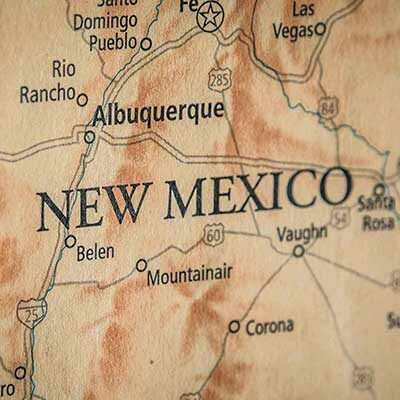Retired USAF firefighter on PFAS: ‘We had no reason to doubt them’
Laura Paskus
August 4, 2021
In the early to mid-1990s, Air Force firefighter Kevin Ferrara was stationed at Cannon Air Force Base in Clovis, New Mexico. It was his first deployment after training at Chanute Air Force Base in Illinois.
Daily, he says, he and other firefighters used Aqueous Film Forming Foam (AFFF), a firefighting foam useful for extinguishing petroleum-based fires. That foam also contains per- and polyfluoroalkyl substances, or PFAS, toxic chemicals linked to a variety of health problems—and known to have contaminated the water at hundreds of military bases nationwide, including Cannon and Holloman Air Force bases.
Ferrara says leadership never mentioned that AFFF could be toxic: “It was repeated: AFFF was ‘soap and water,’ it was perfectly safe,” he says. “And you know, we took that as being the truth because, our leadership, we expected those individuals to know what they were talking about, and we had no reason to doubt them.”
In response to Ferrara’s assertions, Air Force spokesman Mark Kinkade wrote in an email that: “The safety and well-being of our Airmen is a top priority, and we strive to find solutions and reduce risk wherever possible.”
When the Air Force began using AFFF in the 1970s, Kinkade wrote, "it was in accordance with manufacturer instructions and consistent with known occupational risks at the time.” And, he added: “AFFF is highly effective in protecting human health in the event of a petroleum-based fire, and was used by all services, across the firefighting industry, and FAA-certified commercial airports.”
He continued that the Air Force has acted in accordance with the U.S. Environmental Protection Agency’s lifetime health advisory for perfluorooctanoic acid (PFOA) and perfluorooctane sulfonic acid (PFOS), replaced AFFF at bases to reduce exposure to PFOS and PFOA, and “implemented strict training and use guidelines for use of the new foam by our firefighters and emergency personnel.”
In a story co-published with the Santa Fe Reporter, we’ve laid out all these issues, including the years-long battle over PFAS cleanup in New Mexico. You can read “Toxic Threat,” here on the Groundwater War website.
Inspector General report: DOD not doing enough
Meanwhile, a report from the Inspector General of the U.S. Department of Defense tells a somewhat different story.
According to that report, while military officials have “taken steps to steps to identify, mitigate, and remediate contaminant effects from PFAS‑containing AFFF at DoD installations,” they have not “proactively identified, mitigated, and remediated” pollution from PFAS-containing materials other than AFFF.
Moreover, although officials developed a plan to test the blood of active-duty military firefighters—which Congress directed them to do—they do not “plan to track, trend, and analyze” those test results.
According to the IG report, that means the military is “missing an opportunity” to use that exposure data and assess the “significant long-term health effects” of PFAS.
That report also recommends that military officials “formally inform” those associated with Defense Department installments of the presence and use of PFAS-containing materials—and inform them of their hazardous status.
Congressional action on PFAS
Earlier this summer, the U.S. House of Representatives passed the PFAS Action Act. If passed by the U.S. Senate and signed by President Joe Biden, it would require the U.S. Environmental Protection Agency to set a drinking water standard for PFAS and regulate the toxic substances as “hazardous waste” under the Comprehensive Environmental Response, Compensation, and Liability Act (or Superfund).
Rep. Teresa Leger Fernandez was among those supporting that bill. And she introduced an amendment directing EPA to consider not only drinking water standards for PFAS, but also to consider water used for agricultural. That amendment, she says, is directly related to seeing what happened with the Highland Dairy in Clovis, which was contaminated by PFAS from Cannon Air Force Base.
The congresswoman also says she’s been working with the U.S. Department of Agriculture to purchase the contaminated cows from Highland Dairy owner Art Schaap.
Highland Dairy has been “ruined,” she says, because of the PFAS contamination. Once the contamination was found, the milk could no longer be sold, and nor could the cows themselves.
Her amendment to the PFAS Action Act, she says, would protect people in her district, as well as those in other parts of the United States facing similar problems.
The Fourth Estate on PFAS
PFAS contamination isn’t unique to New Mexico. Communities across the nation are grappling with pollution from military installations and manufacturing sites. And that means reporters across the nation are trying to find answers.
Recently, we spoke with Garret Ellison, environment reporter at MLive/Grand Rapids Press, and Michael Sol Warren, environment reporter at NJ Advance Media, about the challenges their communities are facing in Michigan and New Jersey.
If you’ve been affected by PFAS contamination in your community here in New Mexico, call our tip line at (505) 433-7242. To read more coverage of PFAS in New Mexico visit “Groundwater War: New Mexico’s Toxic Threat,” which includes a timeline of events and studies on PFAS.






